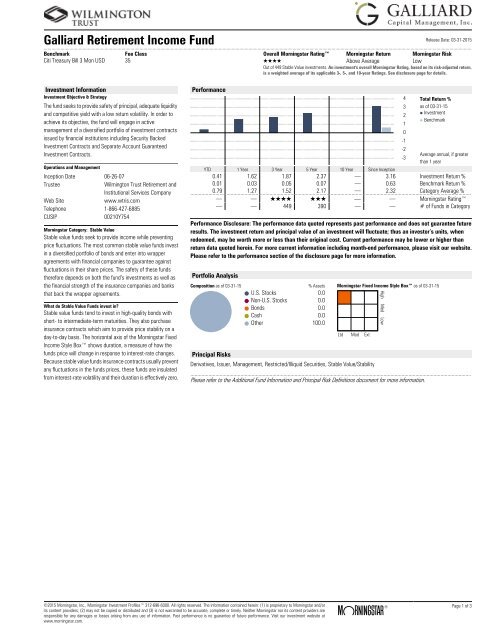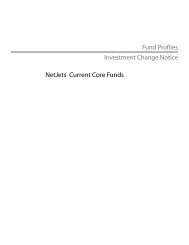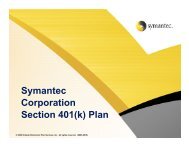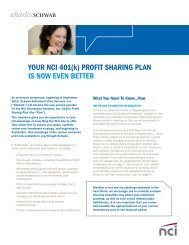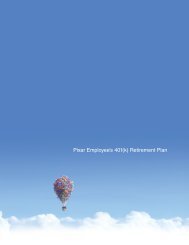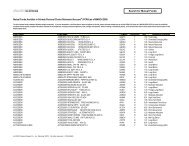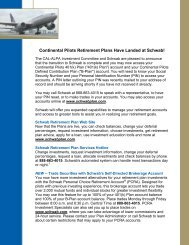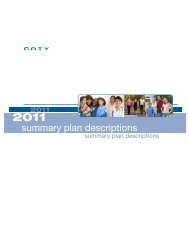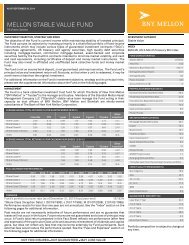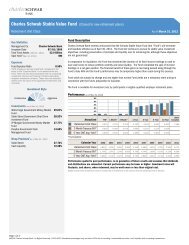Galliard Retirement Income Fund
Galliard Retirement Income Fund Fee CL 35 - Schwab Retirement ...
Galliard Retirement Income Fund Fee CL 35 - Schwab Retirement ...
- No tags were found...
You also want an ePaper? Increase the reach of your titles
YUMPU automatically turns print PDFs into web optimized ePapers that Google loves.
<strong>Galliard</strong> <strong>Retirement</strong> <strong>Income</strong> <strong>Fund</strong><br />
Release Date: 03-31-2015<br />
..........................................................................................................................................................................................................................................................................................................................................<br />
Benchmark Fee Class Overall Morningstar Rating Morningstar Return Morningstar Risk<br />
Citi Treasury Bill 3 Mon USD 35 QQQQ Above Average Low<br />
Out of 449 Stable Value investments. An investment's overall Morningstar Rating, based on its risk-adjusted return,<br />
is a weighted average of its applicable 3-, 5-, and 10-year Ratings. See disclosure page for details.<br />
Investment Information<br />
Investment Objective & Strategy<br />
The fund seeks to provide safety of principal, adequate liquidity<br />
and competitive yield with a low return volatility. In order to<br />
achieve its objective, the fund will engage in active<br />
management of a diversified portfolio of investment contracts<br />
issued by financial institutions including Security Backed<br />
Investment Contracts and Separate Account Guaranteed<br />
Investment Contracts.<br />
Operations and Management<br />
Inception Date 06-26-07<br />
Trustee<br />
Wilmington Trust <strong>Retirement</strong> and<br />
Institutional Services Company<br />
Web Site<br />
www.wtris.com<br />
Telephone 1-866-427-6885<br />
CUSIP<br />
00210Y754<br />
Morningstar Category: Stable Value<br />
Stable value funds seek to provide income while preventing<br />
price fluctuations. The most common stable value funds invest<br />
in a diversified portfolio of bonds and enter into wrapper<br />
agreements with financial companies to guarantee against<br />
fluctuations in their share prices. The safety of these funds<br />
therefore depends on both the fund’s investments as well as<br />
the financial strength of the insurance companies and banks<br />
that back the wrapper agreements.<br />
What do Stable Value <strong>Fund</strong>s invest in?<br />
Stable value funds tend to invest in high-quality bonds with<br />
short- to intermediate-term maturities. They also purchase<br />
insurance contracts which aim to provide price stability on a<br />
day-to-day basis. The horizontal axis of the Morningstar Fixed<br />
<strong>Income</strong> Style Box shows duration, a measure of how the<br />
funds price will change in response to interest-rate changes.<br />
Because stable value funds insurance contracts usually prevent<br />
any fluctuations in the funds prices, these funds are insulated<br />
from interest-rate volatility and their duration is effectively zero.<br />
Performance<br />
Performance Disclosure: The performance data quoted represents past performance and does not guarantee future<br />
results. The YTDinvestment return YTD and principal YTD value of YTD an investment will fluctuate; YTD thus an investor’s units, when<br />
redeemed, may be worth more or less than their original cost. Current performance may be lower or higher than<br />
return data quoted herein. For more current information including month-end performance, please visit our website.<br />
Please refer to the performance section of the disclosure page for more information.<br />
4<br />
3<br />
2<br />
1<br />
0<br />
-1<br />
-2<br />
-3<br />
Total Return %<br />
as of 03-31-15<br />
Investment<br />
Benchmark<br />
Average annual, if greater<br />
than 1 year<br />
YTD 1 Year 3 Year 5 Year 10 Year Since Inception<br />
0.41 1.62 1.87 2.37 . 3.16 Investment Return %<br />
0.01 0.03 0.05 0.07 . 0.63 Benchmark Return %<br />
..........................................................................................................................................................................................................<br />
0.79 1.27 1.52 2.17 . 2.32 Category Average %<br />
. . QQQQ QQQ . . Morningstar Rating<br />
. . 449 390 . . # of <strong>Fund</strong>s in Category<br />
Portfolio Analysis<br />
Composition as of 03-31-15<br />
Principal Risks<br />
% Assets<br />
U.S. Stocks 0.0<br />
Non-U.S. Stocks 0.0<br />
Bonds 0.0<br />
Cash 0.0<br />
Other 100.0<br />
Morningstar Fixed <strong>Income</strong> Style Box as of 03-31-15<br />
Ltd Mod Ext<br />
Derivatives, Issuer, Management, Restricted/Illiquid Securities, Stable Value/Stability<br />
..........................................................................................................................................................................................................<br />
Please refer to the Additional <strong>Fund</strong> Information and Principal Risk Definitions document for more information.<br />
High Med Low<br />
©2015 Morningstar, Inc., Morningstar Investment Profiles 312-696-6000. All rights reserved. The information contained herein: (1) is proprietary to Morningstar and/or<br />
its content providers; (2) may not be copied or distributed and (3) is not warranted to be accurate, complete or timely. Neither Morningstar nor its content providers are<br />
responsible for any damages or losses arising from any use of information. Past performance is no guarantee of future performance. Visit our investment website at<br />
www.morningstar.com.<br />
® Page 1 of 3<br />
ß
Disclosure<br />
Performance data given represents past performance and<br />
should not be considered indicative of future results of the<br />
<strong>Galliard</strong> <strong>Retirement</strong> <strong>Income</strong> <strong>Fund</strong> (the “<strong>Fund</strong>”). The <strong>Fund</strong> is not<br />
registered as an investment company under the Investment<br />
Company Act of 1940. The <strong>Fund</strong> is not FDIC-insured, may lose<br />
value and is not guaranteed by a bank or other financial<br />
institution.<br />
Performance data reflects a specific class of units. Other fee<br />
classes may currently be available or may become available in<br />
the future. Not all fee classes are available for investment by<br />
all plans. In cases where a specific fee class was not yet<br />
launched as of the date of this Disclosure Statement, return<br />
figures shown may reflect the performance of a previously<br />
launched fee class. Fees vary across fee classes, and the net<br />
returns investors earn will be different from one fee class to<br />
another.<br />
Management of the <strong>Fund</strong><br />
Trustee: Wilmington Trust <strong>Retirement</strong> and Institutional<br />
Services Company (the “Trustee”) serves as the Trustee of the<br />
<strong>Fund</strong> and maintains ultimate fiduciary authority over the<br />
management of, and investments made, in the <strong>Fund</strong>. The <strong>Fund</strong><br />
is part of the Wilmington Trust <strong>Retirement</strong> and Institutional<br />
Services Company Collective Investment Trust II (the “Trust”)<br />
operated by the Trustee.<br />
Wilmington Trust is a registered service mark. Wilmington Trust<br />
Corporation is a wholly owned subsidiary of M&T Bank<br />
Corporation. Investment management and fiduciary services<br />
are provided by Wilmington Trust Company, operated in<br />
Delaware only, and Wilmington Trust, N.A., a national bank.<br />
Loans, retail and business deposits, and other personal and<br />
business banking services and products are offered by M&T<br />
Bank, member FDIC. Wilmington Trust Investment Advisors,<br />
Inc. is a SEC-registered investment adviser providing<br />
investment management services to Wilmington Trust and M&T<br />
affiliates and clients. Brokerage services, mutual funds, and<br />
other securities are offered by M&T Securities, Inc., a registered<br />
broker/dealer, wholly owned subsidiary of M&T Bank, and<br />
member of the FINRA and SIPC.<br />
Sub-Adviser: <strong>Galliard</strong> Capital Management, Inc.<br />
The Trustee has engaged <strong>Galliard</strong> Capital Management the<br />
“Sub-Advisor” or “<strong>Galliard</strong>”) to act as the Sub-Advisor to the<br />
<strong>Fund</strong>. In this capacity <strong>Galliard</strong> will provide investment advice<br />
and recommendations with respect to the investment of <strong>Fund</strong><br />
assets. <strong>Galliard</strong> is an SEC-registered investment advisor firm<br />
headquartered in Minneapolis, Minnesota and is a whollyowned<br />
investment management subsidiary of Wells Fargo.<br />
<strong>Galliard</strong> focuses exclusively on providing fixed income and<br />
stable value management to institutional investors. For more<br />
information about the Sub-Advisor, visit its website at<br />
www.galliard.com.<br />
Investment Process:<br />
The <strong>Fund</strong> seeks safety of principal and consistency of returns<br />
while attempting to maintain minimal volatility. The <strong>Fund</strong> will<br />
pursue its investment objective through the active<br />
management of a diversified portfolio of investment contracts<br />
issued by financial institutions including Security Backed<br />
Investment Contracts and Separate Account GICs, and the<br />
associated portfolio of underlying assets. The <strong>Fund</strong> may also<br />
hold cash, cash equivalents or other collective investment<br />
trusts with investment objects that are consistent with the<br />
<strong>Fund</strong>’s investment strategy.The Underlying Assets that the<br />
<strong>Fund</strong> may purchase include, but are not limited to U.S. Treasury<br />
securities; U.S. Agency securities; asset-backed securities;<br />
certificates of deposit; corporate securities; sovereign/<br />
supranational securities; mortgage-backed securities;<br />
municipal securities; derivative instruments; money market<br />
instruments; collective funds investing primarily in the<br />
permissible securities aforementioned above. All securities in<br />
the <strong>Fund</strong> are U.S. dollar denominated. The <strong>Fund</strong> is 100%<br />
invested in a Host <strong>Fund</strong> which has the same investment<br />
strategy as the <strong>Fund</strong>.<br />
Benchmark: Citi Treasury Bill 3 Mon USD<br />
The index measures the performance of the last three threemonth<br />
Treasury bill month-end rates.<br />
Notes Regarding Return Information<br />
Return figures represent the total change in net assets with<br />
capital gains and income dividends reinvested. Performance<br />
information is presented net of any applicable trustee fees,<br />
contract fees, or other fees or expenses which are borne by the<br />
<strong>Fund</strong>. See "Fees and Expenses" for more information.<br />
Morningstar Rating<br />
Often simply called the Star Rating, the Morningstar Rating<br />
brings load-adjustments, performance (returns) and risk<br />
together into one evaluation. To determine a fund's star rating<br />
for a given time period (three, five, or 10 years), the fund's riskadjusted<br />
return is plotted on a bell curve: If the fund scores in<br />
the top 10% of its category, it receives 5 stars (Highest); if it<br />
falls in the next 22.5% it receives 4 stars (Above Average); a<br />
place in the middle 35% earns 3 stars (Average); those lower<br />
still, in the next 22.5%, receive 2 stars (Below Average); and<br />
the bottom 10% get only 1 star (Lowest). The Overall<br />
Morningstar Rating is a weighted average of the available<br />
three-, five-, and 10-year ratings.<br />
Morningstar Return<br />
This statistic is a measurement of a fund's excess return over<br />
a risk-free rate (the return of the 90-day Treasury bill), after<br />
adjusting for all applicable loads and sales charges. In each<br />
Morningstar category, the top 10% of funds earn a High<br />
Morningstar Return, the next 22.5% Above Average, the middle<br />
35% Average, the next 22.5% Below Average, and the bottom<br />
10% Low. Morningstar Return is measured for up to three time<br />
periods (three-, five-, and 10-years). These separate measures<br />
are then weighted and averaged to produce an overall measure<br />
for the fund. <strong>Fund</strong>s with less than three years of performance<br />
history are not rated.<br />
Morningstar Risk<br />
This statistic evaluates the variations in a fund's monthly returns<br />
with an emphasis on downside variations. In each Morningstar<br />
Category, the 10% of funds with the lowest measured risk are<br />
described as Low Risk, the next 22.5% Below Average, the<br />
middle 35% Average, the next 22.5% Above Average, and the<br />
top 10% High. Morningstar Risk is measured for up to three<br />
time periods (three-, five-, and ten-years). These separate<br />
measures are then weighted and averaged to produce an<br />
overall measure for the fund. <strong>Fund</strong>s with less than three years<br />
of performance history are not rated.<br />
Morningstar Style Box<br />
For equity funds, the vertical axis shows the market<br />
capitalization of the long stocks owned and the horizontal axis<br />
shows investment style (value, blend, or growth).<br />
For fixed-income funds, the vertical axis shows the credit quality<br />
of the long bonds owned, and the horizontal axis shows interest<br />
rate sensitivity as measured by a bond’s effective duration.<br />
Morningstar seeks credit rating information from fund<br />
companies on a periodic basis (e.g., quarterly). In compiling<br />
credit rating information, Morningstar accepts credit ratings<br />
reported by fund companies that have been issued by all<br />
Nationally Recognized Statistical Rating Organizations<br />
(NRSROs). For a list of all NRSROs, please visit http://<br />
www.sec.gov/divisions/marketreg/ratingagency.htm.<br />
Additionally, Morningstar accepts foreign credit ratings from<br />
widely recognized or registered rating agencies. If two rating<br />
organizations/agencies have rated a security, fund companies<br />
are to report the lower rating; if three or more organizations/<br />
agencies have rated a security, fund companies are to report<br />
the median rating, and in cases where there are more than two<br />
organization/agency ratings and a median rating does not exist,<br />
fund companies are to use the lower of the two middle ratings.<br />
PLEASE NOTE: Morningstar, Inc. is not itself an NRSRO nor does<br />
it issue a credit rating on the fund. An NRSRO or rating agency<br />
ratings can change from time-to-time.<br />
For credit quality, Morningstar combines the credit rating<br />
information provided by the fund companies with an average<br />
default rate calculation to come up with a weighted-average<br />
credit quality. The weighted-average credit quality is currently<br />
a letter that roughly corresponds to the scale used by a leading<br />
NRSRO. Bond funds are assigned a style box placement of<br />
"low", "medium", or "high" based on their average credit quality.<br />
<strong>Fund</strong>s with a low credit quality are those whose weightedaverage<br />
credit quality is determined to be less than "BBB-";<br />
medium are those less than "AA-", but greater or equal to<br />
"BBB-"; and high are those with a weighted-average credit<br />
quality of "AA-" or higher. When classifying a bond portfolio,<br />
Morningstar first maps the NRSRO credit ratings of the<br />
underlying holdings to their respective default rates (as<br />
determined by Morningstar’s analysis of actual historical default<br />
rates). Morningstar then averages these default rates to<br />
determine the average default rate for the entire bond fund.<br />
Finally, Morningstar maps this average default rate to its<br />
corresponding credit rating along a convex curve.<br />
For interest-rate sensitivity, Morningstar obtains from fund<br />
companies the average effective duration. Generally,<br />
Morningstar classifies a fixed-income fund's interest-rate<br />
sensitivity based on the effective duration of the Morningstar<br />
Core Bond Index (MCBI), which is currently three years. The<br />
classification of Limited will be assigned to those funds whose<br />
average effective duration is between 25% to 75% of MCBI's<br />
average effective duration; funds whose average effective<br />
duration is between 75% to 125% of the MCBI will be classified<br />
as Moderate; and those that are at 125% or greater of the<br />
average effective duration of the MCBI will be classified as<br />
©2015 Morningstar, Inc., Morningstar Investment Profiles 312-696-6000. All rights reserved. The information contained herein: (1) is proprietary to<br />
Morningstar and/or its content providers; (2) may not be copied or distributed and (3) is not warranted to be accurate, complete or timely. Neither Morningstar<br />
nor its content providers are responsible for any damages or losses arising from any use of information. Past performance is no guarantee of future<br />
performance. Visit our investment website at www.morningstar.com.<br />
® Page 2 of 3<br />
ß
Disclosure<br />
Extensive. In addition, for non-US taxable and non-US domiciled<br />
fixed income funds static duration breakpoints are used: (i)<br />
Limited: less than or equal to 3.5 years; (ii) Moderate: greater<br />
than 3.5 and less than equal to 6 years; (iii) Extensive: greater<br />
than 6 years.<br />
Fees and Expenses<br />
The participant will incur contract fees, trustee fees, and other<br />
operating expenses related to the <strong>Fund</strong>. Other operating<br />
expenses may include, but are not limited to, audit expenses,<br />
custody service fees, tax form preparation expenses, legal and<br />
other fees. A portion of this fee may be paid by the Trustee to<br />
the <strong>Fund</strong>’s Sub-Advisor for its sub-advisory services to the<br />
<strong>Fund</strong>.<br />
All fees and expenses will be reimbursed from the <strong>Fund</strong> when<br />
they are incurred. Any expenses incurred in connection with the<br />
investment and reinvestment of <strong>Fund</strong> assets including without<br />
limitation, any transfer agency fees, brokerage commissions<br />
and expenses, will be charged against the <strong>Fund</strong>.<br />
Below is a breakdown of the fees on the <strong>Fund</strong>:<br />
<strong>Galliard</strong> <strong>Retirement</strong> <strong>Income</strong> <strong>Fund</strong> Fee Class 35<br />
Management Fee % 0.25<br />
Trustee Fee % 0.10<br />
Service Provider Fee % 0.00<br />
Other Expenses % 0.00<br />
Acquired Fees % 0.28<br />
Gross Ratio % 0.63<br />
Net Expense Ratio % 0.63<br />
Fees and expenses are only one of several factors that<br />
participants and beneficiaries should consider when making<br />
investment decisions.<br />
The cumulative effect of fees and expenses can substantially<br />
reduce the growth of a participant’s or beneficiary’s retirement<br />
account. Participants and beneficiaries can visit the Employee<br />
Benefit Security Administration’s website for an example<br />
demonstrating the long-term effect of fees and expenses.<br />
The example in the following table is intended to explain the<br />
ongoing costs of investing in the <strong>Fund</strong> and to compare these<br />
costs with the ongoing costs of investing in other collective<br />
funds. The table provides information about actual account<br />
values and actual expenses. This example is based on an<br />
investment of $1,000 invested for one year:<br />
<strong>Galliard</strong> <strong>Retirement</strong> <strong>Income</strong> <strong>Fund</strong> Fee Class 35<br />
Balance 03-31-2014 $1,000.00<br />
Balance 03-31-2015 $1,016.24<br />
Expenses (1 year) $3.56<br />
The next example table is also intended to explain the ongoing<br />
costs of investing in the <strong>Fund</strong> and to compare these costs with<br />
the ongoing costs of investing in other collective funds. The<br />
table provides information about hypothetical account values<br />
and hypothetical expenses based on the <strong>Fund</strong>’s actual expense<br />
ratio and an assumed rate of return of 0.00% per year, which<br />
is not the <strong>Fund</strong>’s actual return. The hypothetical account values<br />
and expenses may not be used to estimate the actual account<br />
balance or expenses you paid for the period. This example is<br />
based on an investment of $1,000 invested for one year:<br />
<strong>Galliard</strong> <strong>Retirement</strong> <strong>Income</strong> <strong>Fund</strong> Fee Class 35<br />
Balance 03-31-2014 $1,000.00<br />
Hypothetical Balance 03-31-2015 $993.72<br />
Hypothetical Expenses (1 year) $6.28<br />
Risk Considerations<br />
The decision to invest in the <strong>Fund</strong> and the risks involved in doing<br />
so should be carefully considered. The <strong>Fund</strong> should be<br />
considered a long-term investment.<br />
The Principal Risks that are listed on the first page are described<br />
in the Additional <strong>Fund</strong> Information and Risk Definition booklet<br />
and should be read in connection with this profile.<br />
The value of your investment in the <strong>Fund</strong> will increase and<br />
decrease over time in accordance with changes in the value of<br />
the securities held in the <strong>Fund</strong>. When assets of the <strong>Fund</strong> are<br />
invested in other investment vehicles (such as collective trusts<br />
or mutual funds), the Trustee does not have control over the<br />
trading policies or strategies of such entities.<br />
The Trustee of the <strong>Fund</strong> may change the investment objective<br />
of the <strong>Fund</strong> at any time without prior notice or approval.<br />
Investments in the <strong>Fund</strong> are not insured or guaranteed by any<br />
bank, the FDIC, or any other governmental entity.<br />
Basic Terms and Conditions<br />
This profile is only a summary of some of the key features of<br />
the <strong>Fund</strong> and should be read in connection with the Additional<br />
<strong>Fund</strong> Information and Principal Risk Definitions. Participation in<br />
the <strong>Fund</strong> is governed by the Trust Agreement and the terms of<br />
the participation materials, which must be reviewed and signed<br />
by the plan sponsor or Plan fiduciary. In the event of a conflict<br />
between the provisions of this profile and the Trust Agreement<br />
or participation materials, the Trust Agreement or participation<br />
materials control. Please carefully review the Trust Agreement<br />
and participation materials before investing in the <strong>Fund</strong>.<br />
The <strong>Fund</strong> is maintained by the Trustee as part of the Wilmington<br />
Trust <strong>Retirement</strong> and Institutional Services Company Collective<br />
Investment Trust II , which was established on October 6, 2005.<br />
It is a “group trust” within the meaning of Internal Revenue<br />
Service Revenue Ruling 81-100, as amended, and is exempt<br />
from registration under the Investment Company Act of 1940,<br />
as amended (the “1940 Act”).<br />
For More Information:<br />
This profile is only a summary of some of the key features of<br />
the <strong>Fund</strong>. Please carefully review the Trust Agreement and<br />
participation materials prior to investing in the <strong>Fund</strong>. The Trust<br />
Agreement and participation materials provide limitations on<br />
liability and indemnifications in favor of Trustee. To learn more<br />
or obtain additional materials governing the <strong>Fund</strong>, please<br />
contact your plan sponsor or plan trustee. You may also obtain<br />
a copy of the Trust Agreement and participation materials,<br />
without charge, by contacting:<br />
Wilmington Trust <strong>Retirement</strong> and Institutional Services<br />
Company<br />
c/o Collective <strong>Fund</strong> Client Services<br />
1100 N. Market Street<br />
Wilmington, DE 19801<br />
Tel. 1-866-427-6885<br />
Email: csfundaccounting@wilmingtontrust.com<br />
©2015 Morningstar, Inc., Morningstar Investment Profiles 312-696-6000. All rights reserved. The information contained herein: (1) is proprietary to<br />
Morningstar and/or its content providers; (2) may not be copied or distributed and (3) is not warranted to be accurate, complete or timely. Neither Morningstar<br />
nor its content providers are responsible for any damages or losses arising from any use of information. Past performance is no guarantee of future<br />
performance. Visit our investment website at www.morningstar.com.<br />
® Page 3 of 3<br />
ß


